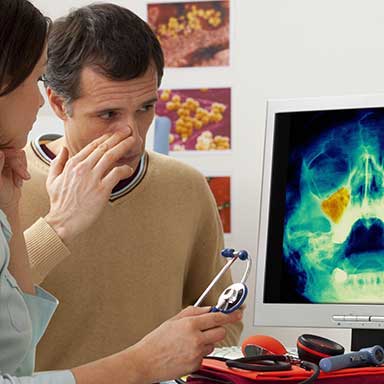Nose Conditions

Sinus Infection
Sinusitis, commonly called a sinus infection, occurs when the normally air-filled sinuses become inflamed or swollen. These conditions can result from things like allergies, nasal polyps, a deviated nasal septum, or a bacterial or viral infection. Symptoms may include facial pain or pressure, swelling around the eyes or cheeks, thick and discolored nasal discharge, and fatigue.
An acute (short-lived) sinus infection can be treated with antibiotics and typically resolves itself shortly. However, some sinus infections may last longer than normal. Chronic sinus infections are those that last longer than 8 weeks. If chronic sinusitis is diagnosed (most often through a CT scan), it may be treatable with medication. However, if the sinus blockage is severe or if the passages that normally allow the sinuses to drain also become blocked, surgical intervention may be required. Possible procedures include a maxillary antrostomy, balloon sinoplasty, or ethmoidectomy. A septoplasty may also be appropriate if a deviated nasal septum is causing your chronic sinus infections.
Nasal Polyps
Nasal polyps are benign (non-cancerous) growths that develop in the lining of the nasal passages. Small polyps may not cause any noticeable symptoms, but larger or multiple polyps can cause nasal obstruction, long-lasting sinus infections, allergies, asthma, and immune disorders. These common conditions include a decreased sense of smell, difficulty breathing through your nostrils, facial pain and headaches, sinus pressure, a runny nose, and heavy drainage behind the nose.
Unfortunately, the cause of nasal polyps is not fully understood, so treatment plans are not always easy to create. Sometimes they can be effectively treated through steroid nasal sprays or Cortisone injections, but if nasal polyps do not respond to conservative treatment, they may need to be surgically removed. Unfortunately, this may not prevent them from coming back.

Broken Nose (Nasal Fracture)
Nasal fractures, better known as broken noses, are often acquired from accidents related to things like contact sports, vehicles, or falls. If you break your nose, you may experience bleeding, bruising, and swelling around the eyes, or even a laceration that could require stitches. The bones may become crooked or misshapen, which could make it difficult for you to breathe through your nostrils.
Broken noses can be evaluated through CT scans of the sinuses and maxillofacial region (the face, mouth, tongue, and jaws). Depending on the type of fracture, it may be possible to manually realign your nose. This technique is most effective if it’s performed within 2-3 weeks of the injury. However, if you are experiencing breathing or other difficulites as a result of the break and manual realignment isn’t an effective option, surgery can realign the bones and correct any issues.
Deviated Nasal Septum
The nasal septum is the bone and cartilage in the nose that separates the nasal cavity into the two nostrils. The conditions of a deviated septum include difficulty with breathing through the nose, snoring, nosebleeds, headaches, poor sleep quality, and sometimes mild to a severe loss of the ability to smell.
Nosebleed (Epistaxis)
The most common cause of nosebleeds is overly dry nasal membranes. These membranes are covered in surface blood vessels which can bleed if they’re damaged or irritated. Nasal sprays or changes in the environment can over-dry these membranes and cause frequent bleeding. Trauma or a deviated nasal septum can also cause nosebleeds.
The cause of chronic nosebleeds can often be found through a CT scan. Nosebleeds conditions can be treated by prescribed ointments, nasal cauterizations, or, if necessary, surgery to change the internal anatomy of your nose.
Sleep Apnea
Sleep apnea can be diagnosed by monitoring you while you sleep and counting how many times you stop or almost stop breathing. There are two classifications of sleep apnea conditions: obstructive sleep apnea involves the tonsils, uvula, soft palate, and nasal septum, while the less-common central sleep apnea results from the brain not communicating with the muscles involved in breathing. Sleep apnea often causes you to snore and can lead to symptoms like extreme fatigue.
C-PAP machines can be used to treat sleep apnea, but Ear, Nose and Throat Specialist evaluation is always a good idea prior to acquiring one; some individuals with obstructive sleep apnea may find their symptoms can be more quickly and easily resolved with surgery. Common procedures to resolve sleep apnea include removing the enlarged tonsils or uvula (the punching bag that hangs in the back of the throat) and straightening a deviated nasal septum.
Allergies
Our immune systems are wired to identify substances that could cause harm to our bodies and create protective antibodies when a foreign substance is identified. When you have allergies, you’re actually experiencing an unwarranted immune response; the antibodies create an inflammatory process by signaling for chemicals, such as histamine, to defend you.
Seasonal allergy symptoms often affect the nasal passages, sinuses, and airways. Common allergy conditions can be triggered by dust, mold, pollen, and animal dander, just to name a few. Allergies can be evaluated by a physician through RAST blood testing or skin testing so that an appropriate treatment plan can be developed. Many people find that using over-the-counter antihistamines can help manage allergy symptoms.
Snoring
The sound of snoring is caused by the vibrations when air collides with the tissues of the mouth and nose. Allergies, illness, alcohol, and weight gain can sometimes cause snoring. However, if snoring becomes very loud, interferes with sleep, or becomes bothersome to your partner, it may be time to see an Ear, Nose, and Throat Specialist. Like sleep apnea conditions, some cases of snoring may be caused due to enlarged tonsils, an enlarged uvula, or a deviated nasal septum; all of these factors will make it difficult for air to pass through the mouth and nose. Removing the tonsils or uvula or straightening the nasal septum through surgery may decrease or eliminate some patients’ snoring.
Loss of Sense of Smell (Anosmia)
Anosmia condition is the partial or complete loss of the sense of smell. … Common conditions that irritate the nose’s lining, such as allergies or a cold, can lead to temporary anosmia. More serious conditions that affect the brain or nerves, such as head trauma, can cause permanent loss of smell.
Cat (CT) Scan of Sinuses
CT stands for computerized tomography. These scans combine a series of x-ray images from multiple viewpoints in order to create a detailed image of the body part in question. Otolaryngologists often use this form of testing to view your sinuses or mastoid bone conditions. CT scans can help to diagnose things like chronic sinus infections, nasal fractures, nasal polyps, and mastoiditis. It’s a painless process that can usually be performed within thirty minutes. If you want, you can request a digital copy of your CT scans to be provided for review during a physician office visit.
